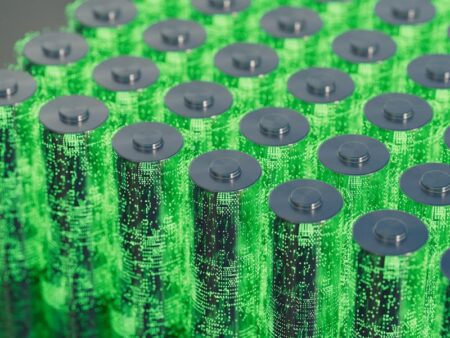Sep
7
Case Made To Replace Lithium Ion With Calcium Ion Chemistry
September 7, 2022 | Leave a Comment
A Rensselaer Polytechnic Institute team proposed a greener, more efficient, and less expensive energy storage alternative to lithium ion. The driving force is concerns regarding scarcity, high prices, and safety regarding the long-term use of lithium-ion batteries.
In research published recently in Proceedings of the National Academy of Sciences (PNAS), corresponding author Nikhil Koratkar, the John A. Clark and Edward T. Crossan Professor of Engineering at Rensselaer, and his team, assert that calcium ions could be used as an alternative to lithium-ions in batteries because of its abundance and low cost.

An image depicting future batteries. Image Credit: Rensselaer Polytechnic Institute. No personal credit shown. Click here to see the image at the press release page. Then right click the image if your browser will display full size.
Dr. Koratkar noted, “The vast majority of rechargeable battery products are based on lithium-ion technology, which is the gold standard in terms of performance. However, the Achilles’ heel for lithium-ion technology is cost. Lithium is a limited resource on the planet, and its price has increased drastically in recent years. We are working on an inexpensive, abundant, safe, and sustainable battery chemistry that uses calcium ions in an aqueous, water-based electrolyte.”
While the larger size and higher charge density of calcium ions relative to lithium impairs diffusion kinetics and cyclic stability, Dr. Koratkar and his team offer oxide structures containing big open spaces (heptagonal and hexagonal channels) as a prospective solution. In their work, an aqueous calcium-ion battery is demonstrated using orthorhombic and trigonal polymorphs of molybdenum vanadium oxide (MoVO) as a host for calcium ions.
Dr. Koratkar explained, “The calcium ion is divalent, and hence one ion insertion will deliver two electrons per ion during battery operation. This allows for a highly efficient battery with reduced mass and volume of calcium ions. However, the higher ionic charge and the larger size of calcium ions relative to lithium makes it very challenging to insert calcium ions into the battery electrodes. We overcome this problem by developing a special class of materials called molybdenum vanadium oxides that contain large hexagonal and heptagonal shaped channels or tunnels that run through the material.”
The team demonstrated that calcium ions can be rapidly inserted and extracted from the material, with these tunnels acting as “conduits” for reversible and fast ion transport and the findings indicate that MoVO provides one of the best performances reported to date for the storage of calcium ions.
“Calcium-ion batteries might one day, in the not-so-distant future, replace lithium-ion technology as the battery chemistry of choice that powers our society,” Dr. Koratkar commented. “This work can lead of a new class of high-performing calcium-based batteries that use Earth abundant and safe materials and are therefore affordable and sustainable. Such batteries could find widespread use in portable and consumer electronics, electric vehicles, as well as grid and renewable energy storage.”
***
Calcium is another intensely interesting battery chemistry rapidly coming into its own. All the different chemistries have attributes that compare well to lithium ion. And each has it own special qualities that are going to challenge designers and consumers in making wise choices.
Everyone is in a hurry to get with the alternatives as lithium pricing is getting past the expensive level. The market potential is huge.
But don’t call lithium out just yet. The lithium metal alternative to lithium ion is also making progress. The metal version of lithium chemistry could cut the lithium required by as much as half for the same capacity.
The next decade is going to see some or most of these alternative chemistries find niches, both small and likely huge ones too. That will be good for consumers.

